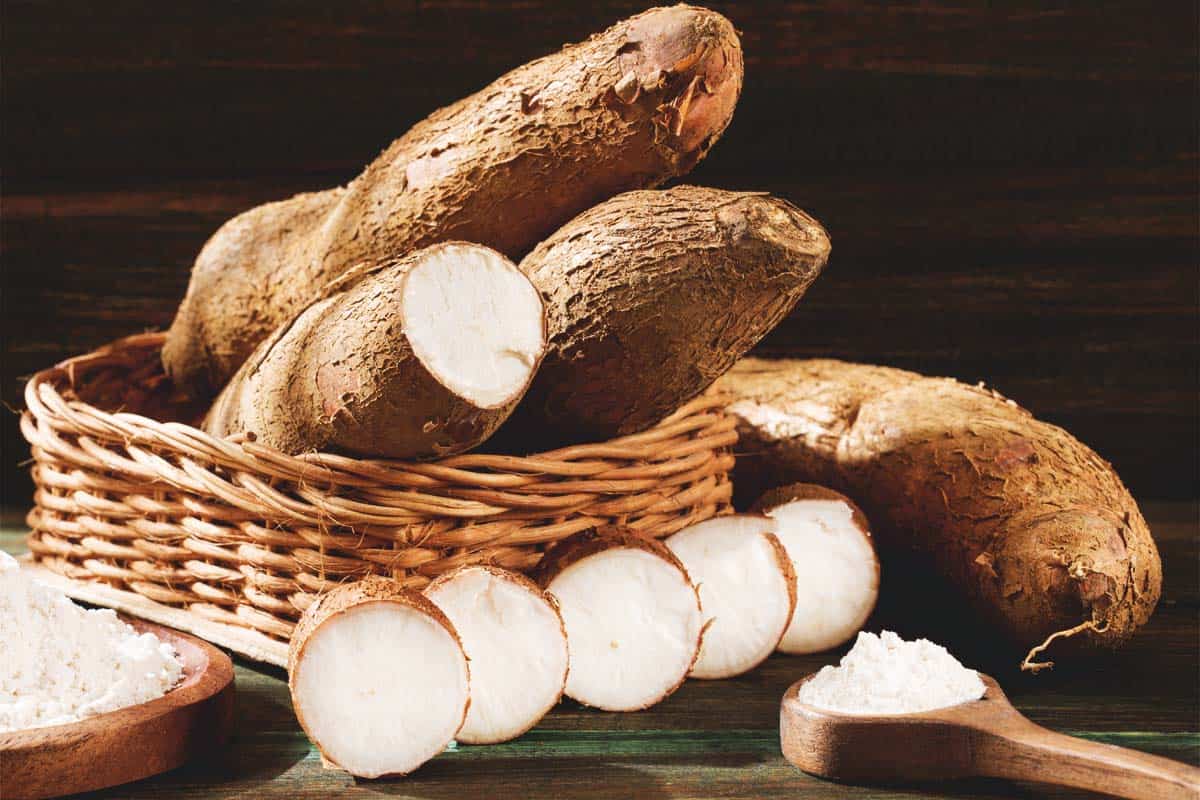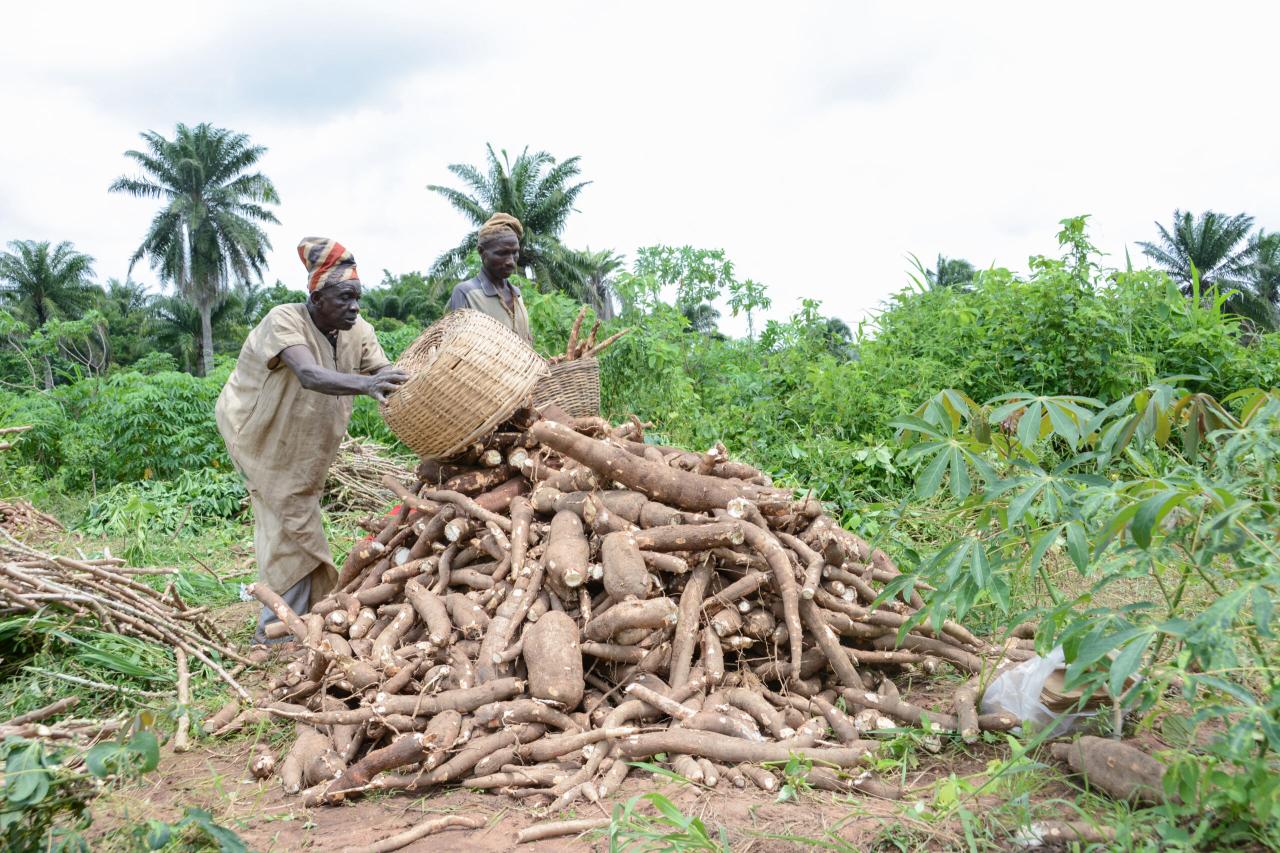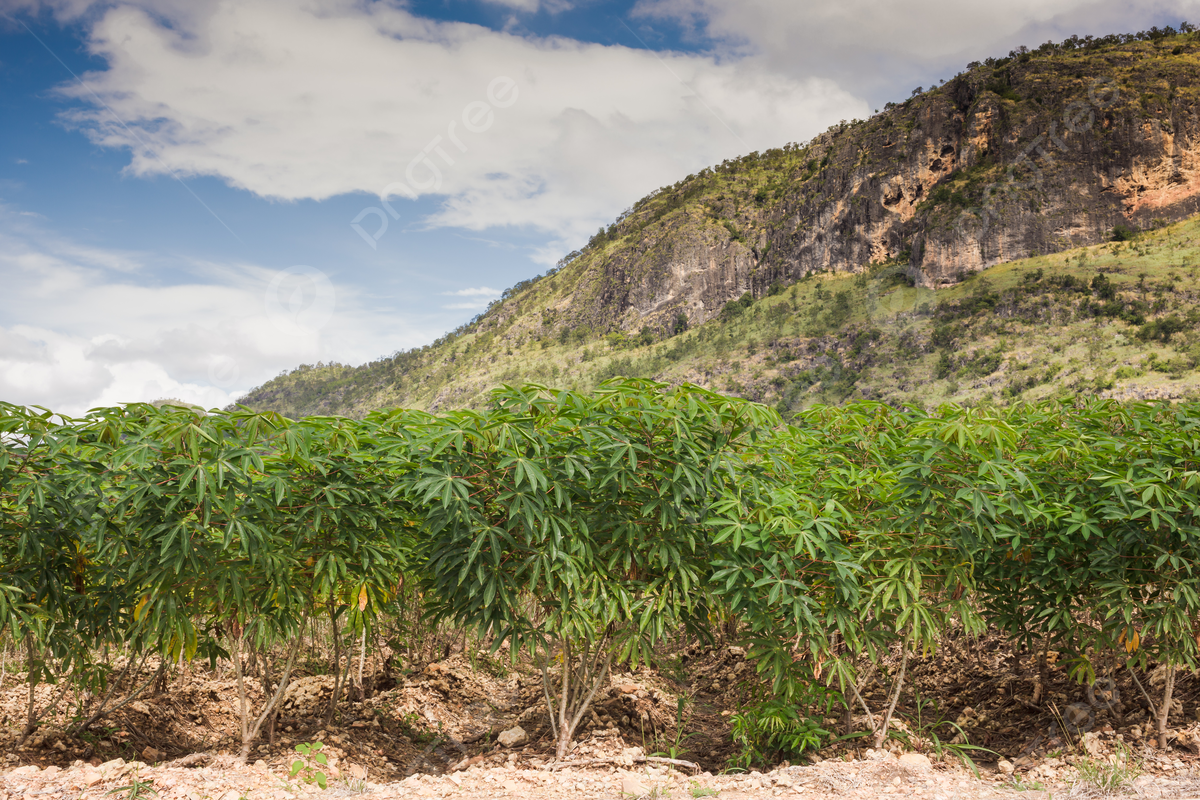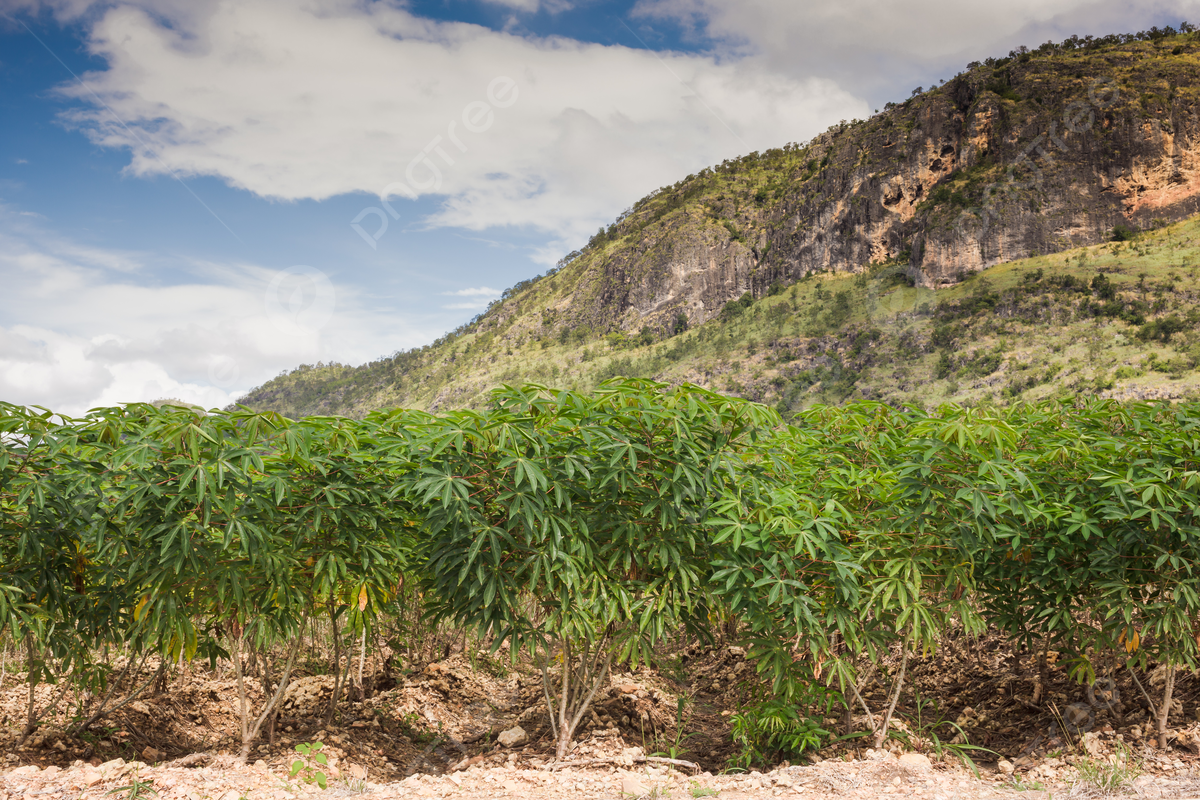How to Achieve a Thriving Cassava Leaf Crop: Essential Tips for Successful Growth sets the stage for this enthralling narrative, offering readers a glimpse into a world of verdant foliage and bountiful harvests. Cassava leaves, a nutritional powerhouse often overlooked, hold immense potential as a valuable food source and a key ingredient in various culinary traditions.
This comprehensive guide delves into the intricacies of cultivating a thriving cassava leaf crop, from selecting the right variety and preparing the soil to mastering irrigation techniques and safeguarding against pests and diseases.
From understanding the nutritional and economic value of cassava leaves to exploring the ideal climate and soil conditions for optimal growth, this guide provides a foundation for success. We’ll cover essential aspects like planting and propagation, soil management, and fertilization, equipping you with the knowledge to cultivate a robust and productive cassava leaf crop.
Understanding Cassava Leaf Crop

Cassava leaves, a nutritious and versatile green leafy vegetable, offer significant nutritional and economic value. They are a rich source of essential nutrients, particularly vitamins A and C, iron, and protein, making them a valuable addition to diets, especially in developing countries.
Cassava leaf production also presents a lucrative agricultural opportunity, contributing to food security and generating income for farmers.
Nutritional and Economic Value of Cassava Leaves
Cassava leaves are a highly nutritious food source, offering a wide range of vitamins, minerals, and antioxidants. They are particularly rich in vitamin A, which is crucial for maintaining healthy vision and immune function. Vitamin C, another abundant nutrient in cassava leaves, plays a vital role in collagen production, wound healing, and boosting the immune system.
Iron, an essential mineral for red blood cell production, is also present in significant amounts. Additionally, cassava leaves are a good source of protein, contributing to overall health and well-being.The economic value of cassava leaves is substantial, particularly in regions where they are a staple food.
They provide a reliable source of income for farmers, contributing to their livelihoods and local economies. The demand for cassava leaves is growing, driven by their nutritional benefits and versatility in culinary applications. This demand creates opportunities for farmers to expand their production and benefit from the market.
Cassava Varieties for Leaf Production
Various cassava varieties exist, each with unique characteristics and suitability for different purposes. When selecting cassava for leaf production, it’s crucial to consider varieties specifically bred for high leaf yield and nutritional value. Here are some examples of cassava varieties suitable for leaf production:
- TMS 60444:This variety is known for its high leaf yield and adaptability to various growing conditions. It is a popular choice for commercial cassava leaf production.
- TMS 30572:Another high-yielding variety, TMS 30572 is well-suited for leaf production and is resistant to cassava mosaic disease, a significant threat to cassava crops.
- TMS 96/0007:This variety is known for its fast growth rate and high leaf production. It is well-suited for regions with short growing seasons.
The selection of the appropriate cassava variety is crucial for maximizing leaf yield and ensuring a successful crop. Factors such as climate, soil type, and disease resistance should be considered when choosing a variety.
Ideal Climate and Soil Conditions for Cassava Leaf Growth
Cassava thrives in warm, tropical climates with ample sunlight and consistent rainfall. It can tolerate a wide range of soil types but prefers well-drained, fertile soils with a pH between 5.5 and 6.5. Here are the ideal climate and soil conditions for optimal cassava leaf growth:
- Temperature:Cassava thrives in temperatures between 25°C and 30°C (77°F and 86°F). It can tolerate temperatures as high as 35°C (95°F) but may experience reduced growth at lower temperatures.
- Rainfall:Cassava requires at least 1000 mm (40 inches) of rainfall per year. However, excessive rainfall can lead to root rot and other diseases.
- Sunlight:Cassava requires full sunlight for optimal growth. It should be planted in an open field with at least 6 hours of direct sunlight per day.
- Soil:Cassava prefers well-drained, fertile soils with a pH between 5.5 and 6.5. Sandy loam soils are ideal, but cassava can grow in a variety of soils, including clay and silt.
Understanding the ideal climate and soil conditions for cassava leaf growth is crucial for maximizing yield and ensuring a successful crop. By providing the right conditions, farmers can optimize cassava growth and produce abundant, nutritious leaves.
Planting and Propagation

Successful cassava leaf production begins with the right planting material and propagation techniques. Choosing healthy cassava cuttings and planting them at the optimal depth and spacing are crucial for maximizing yield and ensuring healthy growth.
Selecting Healthy Cassava Cuttings
Selecting healthy cassava cuttings is essential for a successful cassava leaf crop. Healthy cuttings are free from diseases and pests and have the potential to develop into strong, productive plants.
- Choose cuttings from healthy, disease-free cassava plants.
- Select cuttings with a diameter of at least 2.5 cm and a length of 20-30 cm.This ensures that the cutting has enough energy reserves to support initial growth.
- Ensure the cuttings have at least three nodes.Nodes are the points on the stem where leaves and roots develop.
- Cut the cuttings at a 45-degree angle to facilitate root development.
- Dip the cuttings in a fungicide solution to prevent fungal infections.
Optimal Planting Depth and Spacing
The planting depth and spacing of cassava cuttings play a crucial role in maximizing leaf production. Proper spacing allows for adequate airflow and sunlight penetration, promoting healthy growth and reducing the risk of diseases.
Optimal planting depth:10-15 cm deep.
Optimal spacing:1-1.5 meters between plants and 1-1.5 meters between rows.
Planting Methods
Various planting methods can be employed for cassava leaf production, each with its advantages and disadvantages.
Planting Method |
Advantages |
|---|---|
Direct planting |
Simple and cost-effective. |
Transplanting |
Allows for better control over planting depth and spacing. Provides an opportunity to select the healthiest cuttings. |
Ridge planting |
Improves drainage and aeration, promoting healthy root development. |
Soil Management and Fertilization
Soil fertility is crucial for the successful growth and yield of cassava leaf crops. A fertile soil provides the essential nutrients that cassava plants need to thrive, resulting in abundant leaf production. This section will guide you through the best practices for soil management and fertilization, focusing on both organic and inorganic approaches.
Soil Fertility and Cassava Leaf Growth
Cassava plants require a balanced supply of nutrients, particularly nitrogen, phosphorus, and potassium, for optimal leaf production. These nutrients play vital roles in various plant processes, including photosynthesis, growth, and development. Nitrogen is essential for leaf chlorophyll production, phosphorus promotes root development and nutrient uptake, and potassium contributes to disease resistance and overall plant vigor.
Organic Fertilizer Application
Organic fertilizers are derived from natural sources and offer a sustainable and environmentally friendly approach to enriching soil fertility. They provide a slow and steady release of nutrients, improving soil structure, and promoting beneficial microbial activity.
While nurturing a bountiful cassava leaf crop requires careful attention to soil conditions and irrigation, you can also bring the beauty of nature indoors with a touch of autumnal charm. Consider creating a beautiful leaf garland for your home, following the simple instructions found in this guide , to add a warm and inviting ambiance.
Just as a well-tended cassava plant thrives on proper care, so too will your home flourish with the warmth and beauty of a handmade leaf garland.
- Compost:A well-decomposed mixture of organic materials, such as leaves, food scraps, and manure, compost is rich in nutrients and beneficial microorganisms. It improves soil aeration, water retention, and drainage, creating a favorable environment for cassava growth.
- Manure:Animal manure, such as cow dung, chicken manure, and goat manure, is a rich source of nitrogen, phosphorus, and potassium. It also improves soil structure and microbial activity, enhancing overall soil fertility.
- Green manure:Leguminous plants, like beans and peas, can be grown and incorporated into the soil as green manure. They fix nitrogen from the air, enriching the soil with this essential nutrient.
Inorganic Fertilizer Application
Inorganic fertilizers, also known as synthetic fertilizers, are manufactured from chemical compounds and provide a concentrated source of nutrients. They are readily available and offer a quick boost to plant growth, but their excessive use can lead to environmental problems, such as soil acidification and water pollution.
- Nitrogen (N):Commonly used nitrogen fertilizers include urea, ammonium sulfate, and calcium ammonium nitrate. Nitrogen promotes leaf growth and chlorophyll production.
- Phosphorus (P):Superphosphate, triple superphosphate, and diammonium phosphate are common phosphorus fertilizers. Phosphorus enhances root development and nutrient uptake.
- Potassium (K):Potassium chloride, potassium sulfate, and potassium nitrate are examples of potassium fertilizers. Potassium contributes to disease resistance and overall plant vigor.
Benefits of Using Compost and Manure, How to Achieve a Thriving Cassava Leaf Crop: Essential Tips for Successful Growth
Compost and manure offer numerous benefits for cassava leaf production, promoting sustainable and environmentally friendly practices. They provide a slow and steady release of nutrients, improving soil structure, and enhancing microbial activity. These benefits contribute to a healthy soil environment, promoting robust cassava growth and abundant leaf yield.
- Improved soil structure:Compost and manure enhance soil aeration, water retention, and drainage, creating a favorable environment for root development and nutrient uptake.
- Increased microbial activity:These organic materials promote the growth of beneficial microorganisms, which break down organic matter, release nutrients, and improve soil fertility.
- Reduced reliance on synthetic fertilizers:Organic fertilizers can significantly reduce the need for inorganic fertilizers, promoting sustainable agriculture and minimizing environmental impact.
- Enhanced plant growth:The improved soil structure, nutrient availability, and microbial activity resulting from compost and manure application contribute to robust cassava growth and abundant leaf production.
Irrigation and Water Management
Cassava leaves are a significant source of nutrients, and adequate irrigation is crucial for maximizing their yield and quality. A consistent water supply promotes healthy growth, ensuring lush and nutritious leaves for consumption. This section will discuss the importance of irrigation and compare various methods to help you choose the best option for your cassava leaf crop.
Irrigation Methods and Their Suitability
The choice of irrigation method depends on factors like water availability, terrain, and budget. Here are some common methods and their advantages and disadvantages:
- Drip Irrigation:Drip irrigation delivers water directly to the root zone, minimizing water loss through evaporation. This method is highly efficient, particularly in arid regions. However, it requires a higher initial investment and can be susceptible to clogging.
- Sprinkler Irrigation:Sprinkler irrigation involves spraying water over the entire field. It is cost-effective and easy to install, but it can lead to water wastage through evaporation and runoff, especially in windy areas.
- Surface Irrigation:Surface irrigation involves flooding the field with water, which is a simple and inexpensive method. However, it can be inefficient, leading to waterlogging and nutrient leaching.
Water Requirements at Different Growth Stages
Cassava leaf production is sensitive to water availability throughout its growth cycle. The plant’s water needs vary significantly depending on the stage of growth. The following table summarizes the approximate water requirements at different stages:
Growth Stage |
Water Requirement (mm/week) |
|---|---|
Establishment (first 4 weeks) |
50-75 |
Rapid Growth (4-12 weeks) |
100-150 |
Leaf Harvest (12 weeks onwards) |
75-100 |
Note:The actual water requirements may vary based on factors such as climate, soil type, and plant density. It is essential to monitor the soil moisture regularly and adjust irrigation accordingly.
Pest and Disease Control
Protecting your cassava leaf crop from pests and diseases is crucial for maximizing yield and ensuring the quality of your harvest. These infestations can significantly impact plant health, leading to reduced leaf production, stunted growth, and even crop failure. This section will delve into common pests and diseases affecting cassava leaves, providing practical tips for prevention and management.
Identifying Common Pests and Diseases
Understanding the threats to your cassava leaf crop is the first step in effective pest and disease control. Here are some of the most prevalent pests and diseases that can impact cassava leaves:
- Cassava Mealybug (Phenacoccus manihoti) : This sap-sucking insect infests cassava stems, leaves, and roots, causing leaf distortion, wilting, and reduced growth. Mealybugs secrete honeydew, which attracts sooty mold, further affecting plant health.
- Cassava Green Mite (Mononychellus tanajoa) : These tiny mites feed on cassava leaves, causing stippling (small, yellow spots) and eventually leaf drop. Heavy infestations can lead to significant yield losses.
- Cassava Mosaic Disease (CMD): This viral disease is spread by whiteflies and causes mosaic patterns on leaves, stunting, and reduced yield. CMD is a significant threat to cassava production worldwide.
- Cassava Bacterial Blight (CBB): This bacterial disease affects cassava leaves, stems, and roots, causing wilting, leaf drop, and stem rot. CBB can be particularly damaging in wet conditions.
- Cassava Root Rot: Several fungal pathogens can cause root rot, leading to wilting, leaf yellowing, and eventually plant death. Root rot is often exacerbated by poor drainage and high soil moisture.
Preventing Pest Infestations
Proactive measures are essential for preventing pest infestations and minimizing the risk of disease outbreaks.
- Use disease-free planting material: Always start with healthy cassava cuttings to avoid introducing pests and diseases into your field.
- Practice crop rotation: Rotating cassava with other crops can help break the life cycles of pests and diseases, reducing their populations.
- Maintain good sanitation: Remove and destroy infected plants or plant debris promptly to prevent the spread of diseases.
- Monitor for pests and diseases regularly: Early detection allows for timely intervention and can prevent infestations from becoming widespread.
- Use resistant varieties: Some cassava varieties exhibit resistance to specific pests and diseases, offering an effective preventative measure.
Managing Pest Infestations
When pest infestations occur, it’s crucial to implement effective control measures.
Organic Control Methods
- Encourage natural predators: Beneficial insects, such as ladybugs and lacewings, can help control pest populations. Create a favorable environment for these predators by planting flowers that attract them.
- Use neem oil: Neem oil is a natural insecticide that can effectively control mealybugs and other pests. Apply neem oil to the affected plants, following product instructions.
- Introduce biological control agents: Parasitoids and predators can be introduced to control specific pest populations. Consult with local agricultural experts for advice on appropriate biological control options.
- Use traps: Sticky traps can help capture and monitor flying insects like whiteflies, aiding in early detection and control.
Chemical Control Methods
- Apply insecticides: Insecticides can be effective in controlling pest populations, but they should be used cautiously and only as a last resort. Choose insecticides specifically designed for cassava pests and follow label instructions carefully.
- Apply fungicides: Fungicides can help control fungal diseases affecting cassava leaves and roots. Apply fungicides according to label instructions and consider rotating fungicides to prevent resistance.
Harvesting and Post-Harvest Handling
Harvesting cassava leaves at the optimal time is crucial for maximizing yield and quality. Proper post-harvest handling ensures the leaves retain their nutritional value and freshness.
Harvesting Cassava Leaves
The optimal time to harvest cassava leaves is when they are young and tender, typically between 30 and 60 days after planting. This is because younger leaves are more palatable and contain higher levels of nutrients. The ideal harvesting height is approximately 30 cm above the ground.
This allows for the plant to continue growing and producing new leaves.
Washing and Drying Cassava Leaves
After harvesting, cassava leaves should be thoroughly washed to remove dirt, insects, and other contaminants. This can be done by rinsing them under running water or soaking them in a clean water bath. Once washed, the leaves should be dried to remove excess moisture.
Drying can be done in the sun, in a shaded area, or using a food dehydrator.
Storing Harvested Cassava Leaves
Proper storage is essential for maintaining the quality and freshness of harvested cassava leaves. Leaves can be stored in the refrigerator for up to 5 days. To store them, wrap them in a damp paper towel and place them in a plastic bag.
Alternatively, they can be frozen for up to 3 months. To freeze cassava leaves, blanch them in boiling water for 2-3 minutes, then quickly cool them in an ice bath. Drain the leaves and package them in freezer-safe bags.
Processing and Preserving Cassava Leaves
Cassava leaves can be processed and preserved in various ways to extend their shelf life and enhance their versatility in cooking.
- Drying:Drying cassava leaves is a traditional method of preservation. The leaves can be sun-dried or oven-dried. Dried leaves can be stored for several months and rehydrated before use.
- Fermentation:Fermentation is another effective method for preserving cassava leaves. The leaves are typically fermented with salt, which inhibits microbial growth. Fermented cassava leaves have a unique flavor and are often used in traditional dishes.
- Pickling:Pickling is a process that involves preserving food in vinegar, salt, and other seasonings. Pickled cassava leaves have a tangy flavor and can be stored for several months.
Tips for Maximizing Yield

Achieving a bountiful cassava leaf harvest requires a combination of strategic practices that optimize plant growth and minimize losses. By understanding the factors influencing yield and implementing appropriate techniques, you can significantly enhance your cassava leaf production.
Impact of Planting Density and Spacing
Proper spacing is crucial for maximizing cassava leaf yield. Overcrowding can lead to competition for resources, resulting in stunted growth and reduced leaf production. On the other hand, excessive spacing can lead to inefficient use of land and resources.
- Recommended Spacing:The optimal spacing for cassava leaf production varies depending on the variety and growing conditions. However, a general guideline is to maintain a spacing of 60-90 cm between plants and 1-1.5 m between rows. This spacing allows for adequate sunlight penetration, air circulation, and root development.
- Benefits of Proper Spacing:
- Improved light penetration and photosynthesis, leading to increased leaf growth.
- Enhanced air circulation, reducing disease incidence and pest infestations.
- Adequate space for root development, resulting in higher tuber yields.
Fertilizer Application for Enhanced Growth
Fertilizers provide essential nutrients for optimal cassava leaf growth. Proper fertilization ensures that the plants have access to the nutrients they need to produce abundant leaves.
- Nutrient Requirements:Cassava plants require significant amounts of nitrogen, phosphorus, and potassium for healthy growth. Nitrogen is particularly important for leaf production, while phosphorus promotes root development. Potassium aids in disease resistance and overall plant health.
- Fertilizer Application Methods:
- Basal Application:Applying fertilizer at the time of planting provides a steady supply of nutrients to the growing plants. This method is particularly effective for phosphorus and potassium, which are less mobile in the soil.
- Topdressing:Applying fertilizer periodically throughout the growing season ensures a continuous supply of nutrients, particularly nitrogen, which is readily leached from the soil. Topdressing is typically done every 4-6 weeks.
- Foliar Application:Spraying fertilizer solutions directly onto the leaves can be a quick and efficient way to provide essential nutrients. This method is particularly useful for micronutrients, which are often deficient in the soil.
Pest and Disease Control for Yield Protection
Pests and diseases can significantly reduce cassava leaf yield by damaging the leaves and hindering plant growth. Effective pest and disease control measures are essential for protecting your crop and maximizing yield.
Cultivating a thriving cassava leaf crop requires understanding the plant’s needs and providing optimal growing conditions. From ensuring adequate sunlight and water to managing pests and diseases, there are many factors to consider. While cassava might not be the first plant that comes to mind for a beautiful garden, incorporating a Jacaranda tree can add a touch of elegance and visual interest.
For expert tips on how to use this stunning tree in your garden design, check out How to Use Jacaranda Tree for a Unique and Elegant Garden Design: Expert Tips. Just as the Jacaranda tree can transform a garden, with proper care and attention, your cassava leaf crop can flourish and provide a bountiful harvest.
- Integrated Pest Management (IPM):IPM is a comprehensive approach that combines various methods to control pests and diseases, minimizing the use of chemical pesticides.
- Cultural Control:This involves using practices such as proper spacing, crop rotation, and sanitation to minimize pest and disease pressure.
- Biological Control:This method utilizes natural enemies, such as beneficial insects and microorganisms, to control pests.
- Chemical Control:This involves using pesticides as a last resort when other methods are ineffective. It is crucial to use pesticides responsibly and follow label instructions carefully.
Role of Intercropping and Crop Rotation
Intercropping and crop rotation are effective strategies for maximizing cassava leaf yield by improving soil fertility, suppressing pests and diseases, and enhancing overall productivity.
- Intercropping:Growing cassava with other crops, such as legumes or cereals, can provide several benefits. Legumes, for example, can fix nitrogen in the soil, enriching the soil for cassava growth. Intercropping also helps to diversify the ecosystem, reducing the risk of pest and disease outbreaks.
- Crop Rotation:Alternating cassava with other crops in a planned sequence can help to break the life cycle of pests and diseases, improve soil health, and reduce the risk of nutrient depletion. For example, rotating cassava with legumes can help to improve soil fertility and reduce the incidence of soil-borne diseases.
Closing Notes: How To Achieve A Thriving Cassava Leaf Crop: Essential Tips For Successful Growth
By following the essential tips Artikeld in this guide, you can unlock the potential of cassava leaves and reap the rewards of a thriving crop. From understanding the nuances of soil fertility and irrigation to mastering pest control and harvesting techniques, each step contributes to a successful and bountiful harvest.
As you embark on your journey to cultivate a thriving cassava leaf crop, remember that dedication, careful planning, and a commitment to sustainable practices will yield the most rewarding results.
Commonly Asked Questions
What are the main benefits of growing cassava leaves?
Cassava leaves are a rich source of essential nutrients, including vitamins, minerals, and protein. They are also a good source of dietary fiber and antioxidants. Growing cassava leaves can provide a sustainable and nutritious food source, especially in regions where food security is a concern.
How often should I fertilize my cassava plants?
The frequency of fertilization depends on the type of fertilizer used and the soil conditions. Generally, it’s recommended to fertilize cassava plants every 4-6 weeks during the growing season. However, it’s important to monitor the plant’s growth and adjust the fertilization schedule accordingly.
What are some common pests and diseases that affect cassava leaves?
Common pests include mealybugs, whiteflies, and aphids. Diseases that can affect cassava leaves include cassava mosaic disease and bacterial blight. It’s essential to identify these pests and diseases early and take appropriate control measures to prevent significant damage to the crop.
How long does it take for cassava leaves to mature and be ready for harvest?
Cassava leaves typically mature within 4-6 months after planting, depending on the variety and growing conditions. The optimal time for harvesting is when the leaves are fully grown and healthy, with a vibrant green color.
What are some ways to preserve harvested cassava leaves for longer shelf life?
Harvested cassava leaves can be preserved through various methods, including drying, freezing, and pickling. Drying involves removing moisture from the leaves, while freezing preserves them at low temperatures. Pickling involves immersing the leaves in a brine solution to extend their shelf life.
